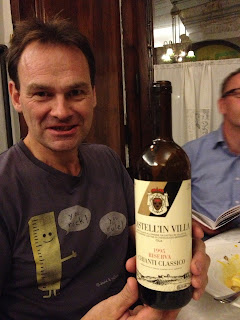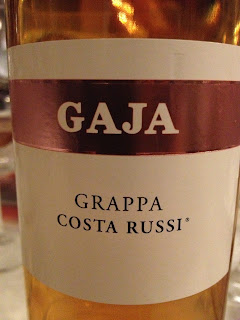Restauranten har et veldig bra vinkart. Bl.a. dette ...
Vincent Dauvissat Chablis ’09 € 29,00
Vincent Dauvissat Chablis «La Forest» ’07/’09 € 40,00
Vincent Dauvissat Chablis «Les Clos» ’09 € 60,00
Vincent Dauvissat Chablis «Les Clos» ’07 € 70,00
Chablis Les Clos 2007, Vincent Dauvissat
Lukket og kald, kommer seg noe etter en 1/2 time, men denne burde stått 2t. i karaffel. Noe honning og citrus, men vinen blir for tilknappet og vanskelig. 90-94 poeng.Cepparello 2006 IGT, Isole e Olena
Floral, grønn og stram. En Cepparello uten eleganse, den blir for mørk, rå og uferdig. Bør ytterligere lagres. 89-91 poeng.Chianti Classico Riserva 1995, Castell`in Villa
Utviklet vin med toner av blåbær og rosin, bra syre. Ganske flat og lett i munnen og mangler spenst . Sursøt og dør litt ut. Bør ikke lagres. Flaskefeil ? 86 poeng
Brunello di Montalcino Riserva 2004, Poggio di Sotto
Stram og uforløst. En kraftig brunello, men samtidig på den elegante siden. Syrlig, bark, litt grønn, men fremfor alt en frisk, stålaktig, balansert og deilig munnfølelse. Robuste kirsebær, genuin frukt, ikke et sjarmtroll, men solid. 93 poeng.
This disciplined approach was hardly confined to Palmucci’s early efforts. In 1997, he collaborated with the University of Milan in order to plant new vineyards (constituting seven hectares), instituting an intensive study regime dedicated to identifying the appropriate clones for the site in question, as well as the planting systems and vine density most conducive to the terroir. (In 1999, a three-hectare vineyard was added to the holdings, raising Poggio di Sotto’s total vineyard acreage to 12 hectares.) These assiduous efforts in the vineyard are maximized through rigorous pruning and an intense process of selection. The former is conducted when the grapes are green in color and arranged in small bunches. This is followed up by the latter effort, during which the grape quantity is reduced by 50 to 60 percent, rendering the production of the estate necessarily minute. Cellar operations are no less exacting in Poggio di Sotto’s gravity flow winery, a classic context that reflects the integration of traditional principles and modern accoutrements. This merger of philosophies, in fact, characterizes the estate’s overall operations.
Adamant about color correctness in Brunello, Palmucci believes that dark Brunellos are disingenuous—wines that cannot possibly be pure-varietal expressions. Thus, a Poggio di Sotto Brunello visually corroborates this stance, exhibiting a medium-red garnet color upon release. It also offers a formidable tannic structure and high level of acidity. While delivering a traditional character, achieved through extended maceration in wooden oak and aging in Slavonian oak barrels, several contemporary enhancements ensure the integrity of the wine’s condition.
For the 2001 vintage, Palmucci released a special bottling—Il Decennale—marking the culminating effort of his first phase as a winemaker. Il Decennale represents, in effect, a viticultural thesis, capturing and celebrating Palmucci’s profound and intimate understanding of the old vines and ancient Sangiovese clones that he utilized to constitute the foundation of vineyards he established in the late 1980s, complementing their character with careful and astute site selection in Castelnuovo dell’Abate. The first and last of its kind, Il Decennale also constitutes the estate’s Riserva for 2001, as it was aged in accordance with the stipulations governing the Riserva designation.
A wine produced each vintage in selecting the best oak vat in the cellar, which generally corresponds to the ecological niche of the vineyards at 200 m asl. The production area is close to Castelnuovo dell’Abate, in the river Orcia valley. The pruning system is cordon spur. Harvest is manual, in cases containing 15-20 kg, in the middle-end of September. Yield per hectare is 30-35 q. The selection is made many times in the vineyard and also before the pressing of the grapes. Vinification in oak vats, spontaneous fermentations by indigenous yeasts and long macerations, with several pumping-over during the day. The wine ages 60 months in 30 hl oak casks and 12 months in bottle. There is no filtering before bottling. 3 500 bottles.
Echezeaux Grand Cru 2002, Vincent Girardin
Parfymert nese med mint, appelsin og myggspray med sitrontilsetning. Lekker vin, kanskje litt mye av alt i en oversjøisk stil. Deilig fløyel i munnen, men vi savnet litt "staying power". For søt i munnen, men en vellykket vin. Vi har jo drukket denne produsenten tidligere i 2002 årgangen og han lagde strålende viner dette året. 92 poeng.
Chianti Classico Riserva Berardenga Vigneto Rancia 1985, Felsina
Frisk og syrlig. Frukten er intakt i vinen. Minner endel om 2006 som vi smakte tidligere på kvelden. Pene kirsebær som har holdt seg godt i 27 år. Litt sliten i glasset etterhvert, med rosiner og roser/Piemonte. 88-90 poeng.
Montevertine Riserva 1985
Litt uklar med snev av brun nedfallsfrukt og epler. Sursøt, tobakk og mangler friskhet. Igjen...10 år gamle Sangiovese behøver nødvendigvis ikke bli bedre med alder. Må ikke forveksles med Bordeaux ! 84 poeng
Barolo Cannubi 1998, Paolo Scavino
Eik, eik, eik. Søtlig og uelegant Barolo. 84 poeng
Fra cellartracker: Ripe, sweet red fruit, heavily marked by new oak. After about 2 hours of
air, the oak began to calm down and integrate, and the main palate impression is
pure red cherries, with toasty woodsmoke notes and suave tannins that build to a
long finish. This is unabashedly modern, well-made and nicely balanced, but
there really isn't much Barolo signature here -- in a blind tasting it would be
hard to differentiate this from a well-made Rioja, Bordeaux, new-wave Tuscan,
etc












Ingen kommentarer:
Legg inn en kommentar